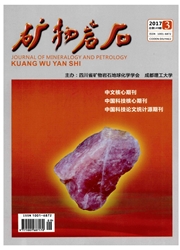

 中文摘要:
中文摘要:
三叠纪是地球环境的重大变革时期,海水锶同位素组成的研究也较为困难。三叠纪海水的^87Sr/^86Sr值或是在短时间内剧烈变化(如早三叠世),或是在较长时间内保持稳定(如中三叠世晚三叠世早期);已公布的全球海水锶同位素曲线也具有显著的不一致性。早三叠世约10Ma时间中海水^87Sr/^86Sr值在海平面上升的背景下反而急剧增加,其控制因素与二叠/三叠纪生物绝灭事件之后的生态空白、尤其是全球古陆缺乏植被的保护和相应的侵蚀作用加剧有关;早三叠世末全球生态环境的逐步恢复(尤其是大陆植被的复苏)以及该时间间隔中的火山作用是全球海平面上升背景下早三叠世末中三叠世早期海水^87Sr/^86Sr值的下降的主要控制因素;中三叠世-晚三叠世早期海水^87Sr/^86Sr值的长时间稳定主要与全球海平面持续上升的背景下,大范围分布的陆表海对放射性成因锶的保护作用有关;古特提斯洋的关闭、西米里亚大陆与欧亚大陆的碰撞造山、以及全球海平面的显著下降造成了晚三叠世中期以后再次出现的海水^87Sr/^86Sr值增加。
 英文摘要:
英文摘要:
Triassic is a period with a great change in global environment,so it is more difficult to study its strontium isotopic composition of seawater. The Strontium isotope curve of Triassic seawater evolves in an elusory form. The ^87Sr/^86Sr value of seawater changed rapidly in a short time of early Triassic, but varied little from middle Triassic to early period of late Triassic. The published Strontium isotope curves of global seawater are different. It is difficult to understand why the sharp rise in the ^87Sr/^86Sr values at early Triassic (about 10 Ma) was coupled with the global sea-level rise. It is thought that the most important reason should be the absence of a dense protective land plant cover following the mass extinction occurred in the latest Permian, leading to the enhanced erosion of land. The recovery in ecology, especially recovery of land vegetation during the latest early Triassic, coupled with the volcanism and transgression is the reason for the decrease of ^87Sr/^86Sr value at the boundary of early/middle Triassic. During middle Triassic to early period of late Triassic (approximately 235 Ma to 220 Ma), with the global sea-level constant rising, the stabilization of ^87Sr/^86Sr value of seawater are caused by the protection from extensive epicontinental seas to radiogenic Strontium. The closure of Paleo-tethys,the collision of Cimmerian continent with Eurasia,and the global sea-level falling make the ^87Sr/^86Sr value ascend again after the middle period of Late Triassic.
 同期刊论文项目
同期刊论文项目
 同项目期刊论文
同项目期刊论文
 期刊信息
期刊信息
